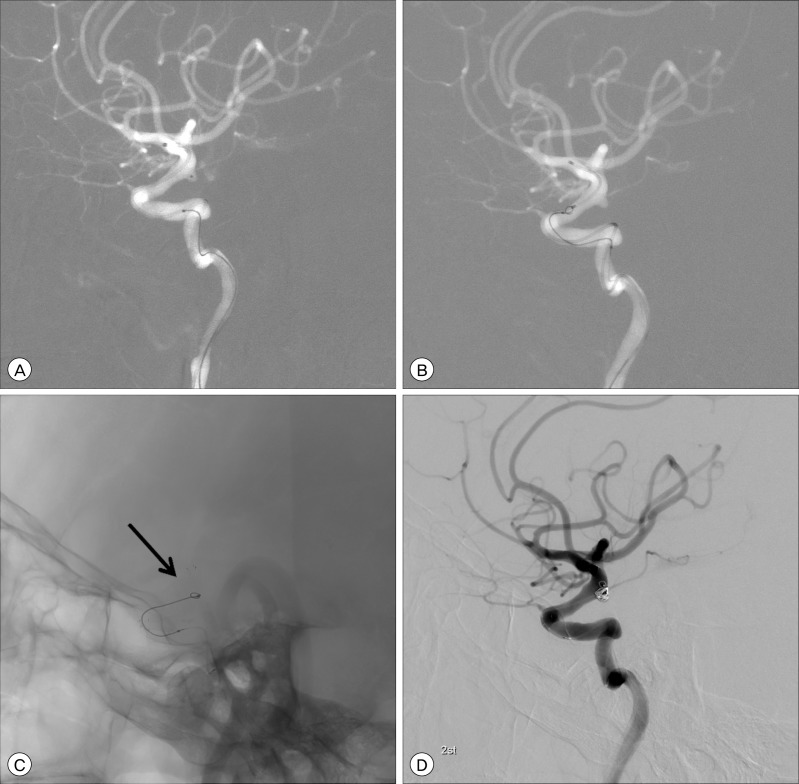J Cerebrovasc Endovasc Neurosurg.
2013 Dec;15(4):293-298. 10.7461/jcen.2013.15.4.293.
Jailing Technique Using a Catheter-based Open-cell Stent System in Internal Carotid Artery Sidewall Aneurysms Unfeasible to Simple Coiling
- Affiliations
-
- 1Department of Neurosurgery, Busan Paik Hospital, Inje University, Busan, Korea.
- 2Department of Neurosurgery, Haeundae Paik Hospital, Inje University, Busan, Korea. kusmal@hanmail.net
- 3Department of Diagnostic Radiology, Busan Paik Hospital, Inje University, Busan, Korea.
- KMID: 1810787
- DOI: http://doi.org/10.7461/jcen.2013.15.4.293
Abstract
OBJECTIVE
An open cell stent system may offer better apposition of cell struts to vessel wall than a closed cell stent system in acute vasculature. The purpose of this study was to evaluate the feasibility of coiling using the jailing technique with the Neuroform EZ stent system.
METHODS
The jailing technique using the open-cell stent system of the Neuroform EZ stent was planned in 22 consecutive patients with 22 cerebral aneurysms. We retrospectively evaluated the technical success of the jailing technique and the occurrence of interference between two microcatheters as well as the factors influencing this interference.
RESULTS
The jailing technique was successful in 19/22 patients (86.4%), and interference between two microcatheters occurred in 6/21 (28.6%). The jailing technique failed in 3/22 patients, with problems that included failure of the stent delivery system to advance into the positioned microcatheter in one, interference between the microcatheters during the advancement of the stent delivery system in one, and failure of microcatheter insertion into the aneurysm sac in the remaining patient. Interference between the two microcatheters developed during the advance of the stent delivery system into the positioned microcatheter in all cases. One factor that influences interference between two microcatheters more than expected by chance is the carotid siphon angle (p = 0.019).
CONCLUSION
The acuteness of the carotid siphon angle influences the interference between two microcatheters. Therefore, the jailing technique using the Neuroform EZ stent should be performed carefully in cerebral aneurysms with an acute carotid siphon angle because the procedure may possibly fail.
Keyword
MeSH Terms
Figure
Cited by 1 articles
-
The Interference Phenomenon of Microcatheters in the Jailing Treatment for Internal Carotid Artery Side Wall Aneurysms with an Open Cell Stent System
Minwook Yoo, Sung-Chul Jin, Seung-Hwan Kim, Byeong-Sam Choi, Hae Yu Kim, SungJun Lee, Sung Tae Kim, Hae Woong Jeong
J Cerebrovasc Endovasc Neurosurg. 2016;18(4):363-368. doi: 10.7461/jcen.2016.18.4.363.
Reference
-
1. Biondi A, Janardhan V, Katz JM, Salvaggio K, Riina HA, Gobin YP. Neuroform stent-assisted coil embolization of wide-neck intracranial aneurysms: Strategies in stent deployment and midterm follow-up. Neurosurgery. 2007; 9. 61(3):460–468. discussion 468-9. PMID: 17881956.2. Heller RS, Malek AM. Parent vessel size and curvature strongly influence risk of incomplete stent apposition in enterprise intracranial aneurysm stent coiling. AJNR Am J Neuroradiol. 2011; 10. 32(9):1714–1720. PMID: 21816918.
Article3. Heller RS, Miele WR, Do-Dai DD, Malek AM. Crescent sign on magnetic resonance angiography revealing incomplete stent apposition: Correlation with diffusion-weighted changes in stent-mediated coil embolization of aneurysms. J Neurosurg. 2011; 9. 115(3):624–632. PMID: 21619405.
Article
- Full Text Links
- Actions
-
Cited
- CITED
-
- Close
- Share
- Similar articles
-
- The Interference Phenomenon of Microcatheters in the Jailing Treatment for Internal Carotid Artery Side Wall Aneurysms with an Open Cell Stent System
- Electrothermal Coil Detachment Failure in Flow Diverter-Assisted Coiling of a Small Blister Aneurysm: Technical Considerations and Possible Solutions
- Temporary Semi-Jailing Technique Avoiding Inevitable Antiplatelet Medication for Coil Embolization of Wide-necked Cerebral Aneurysms
- Kissing Aneurysms at Fenestrated Proximal Basilar Artery: Double-barrel Stent-assisted Coiling Using Dual Closed-cell Stents
- Five Aneurysms Arising from the Ipsilateral Internal Carotid Artery : Case Report


